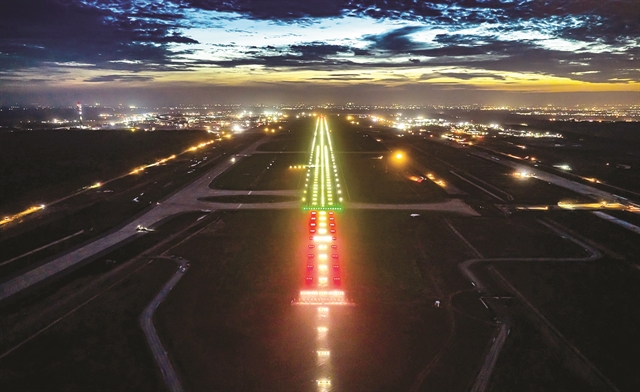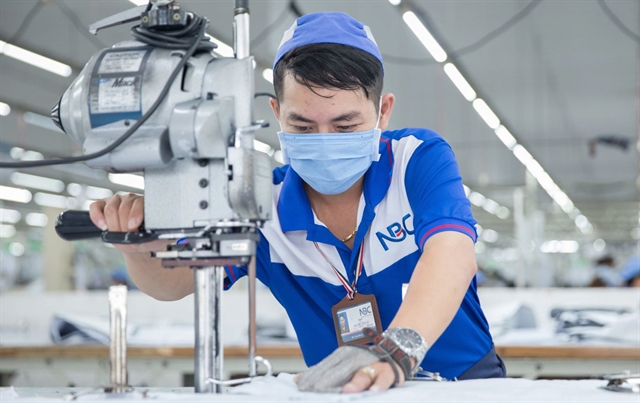 Society
Society


|
| A worker in Nhà Bè Garment Corporation. Photo courtesy of vnexpress.net |
HCM CITY — Many businesses in HCM City have expanded their production facilities to neighbouring provinces, making it easier to recruit workers at a time recruitment has become difficult.
After the pandemic-inflicted lockdowns, production has recovered at the Nhà Bè Garment Corporation in District 7, with orders to be fulfilled until the third quarter of 2022.
In order to attract newcomers, the company has raised the monthly income to VNĐ10 – 15 million along with perks like 13th-month salary, productivity bonus, vocational training, scholarships for workers’ children and home repair assistance.
“However, it is still not easy to find workers in HCM City,” said Lê Thị Hà Chi, deputy general director of the company, adding that companies in neighbouring provinces received two to three times more job applications per day.
Chi said that while it takes VNĐ10 million per month to hire a worker in the city, it is VNĐ7 million per month elsewhere, since workers are able to work closer to home where the cost of living is lower.
Over the past five years, Nhà Bè Garment Corporation has expanded production to 10 provinces in the western, central and Central Highlands regions.
It has a total of 20,000 employees, with as many as 15,000 working in factories outside HCM City.
Bringing factories closer to the labour source helps businesses increase production capacity; and as labour costs in neighbouring provinces are lower, the company is able to create a competitive pricing advantage for itself.
Similarly, the Việt Nam Samho Company, which specialises in making leather shoes in HCM City’s Củ Chi District, has built a factory in the Mekong Delta province of An Giang.
Đỗ Trương Hoàng Phúc, head of the company's human resource department, said that the demand for new workers in the two factories after the Lunar New Year holiday reached several thousand people. New workers were found more easily in An Giang Province, he said.
The human resource department of the factory in An Giang receives more than 100 applications every day, while the highest daily number in HCM City is 30.
Early this month, the factory in An Giang even helped recruit new workers for its sister establishment in the city.
Nguyễn Thị Thuỷ, deputy chairwoman of the Việt Nam Textile and Apparel Union, said most of the group members were planning to expand operations to neighbouring provinces.
It would help solve the labour shortage problem in big cities, especially HCM City, she said.
Like others, Thủy also added that businesses can reduce labour costs in terms of wages and social insurance while local workers no longer have to leave their hometown to earn a living.
Difficulties persist
Despite certain advantages, factories in neighbouring provinces also face many difficulties. As workers live with their families, they have the tendency to take leave or even quit when certain personal events occur.
In addition, as factories in some localities are far from ports and airports, logistics costs become higher.
A lack of quality workers is another challenge that some factories have faced.
According to public policy expert Nguyễn Quang Đồng, setting up factories in neighbouring provinces not only addresses labour shortage, but also contribute to improving workers' lives.
The exodus of millions of workers from HCM City to their hometowns during the fourth COVID-19 outbreak revealed shortcomings in the support policies for migrant workers in the city, he said.
Since workers cannot buy houses or raise their children in the city, the latter are usually sent to live with relatives in the countryside. The social consequences of families being separated thus are huge, experts have said.
The Centre for Industrial Relations Research has noted that insufficient living wages and high urban living costs are two reasons why workers in southern provinces and cities returned to their hometowns during the COVID-19 outbreak. Later, many of them did not return to the city even after the pandemic was brought under control.
"Workers are paying a hefty price for 30 years of industrial development and this situation needs to be stopped soon," Đồng said.
He acknowledged that labour-intensive industries like textiles and garments and footwear will continue to play an important role in creating jobs for untrained workers in the coming years.
However, the State needs to roll out appropriate policies and encourage movement of factories closer to labour sources, Đồng said.
Localities like HCM City, Đà Nẵng and Đồng Nai should focus on developing technology groups and using highly qualified human resources.
Meanwhile, quality infrastructure including ports should be built in provinces with a large labour force. Tax incentives and low-interest loans for new factories in such places should be emphasised, he added. — VNS